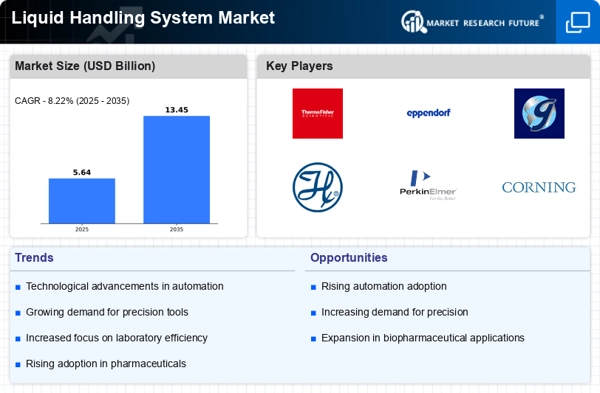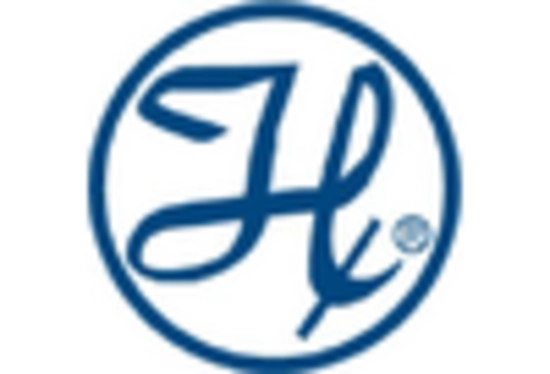Manual
Automated
Electronic
Drug Discovery
ADME Screening
High-throughput Screening (HTS)
Compound Weighing And Dissolution
Others
Pharmaceutical & Biotechnology Companies
Contract Research Organization (CRO)
North America Liquid Handling System by TypeManual
Automated
Electronic
North America Liquid Handling System by ApplicationDrug Discovery
ADME Screening
High-throughput Screening (HTS)
Compound Weighing And Dissolution
Others
North America Liquid Handling System by End UserPharmaceutical & Biotechnology Companies
Contract Research Organization (CRO)
US Liquid Handling System by TypeManual
Automated
Electronic
US Liquid Handling System by ApplicationDrug Discovery
ADME Screening
High-throughput Screening (HTS)
Compound Weighing And Dissolution
Others
US Liquid Handling System by End UserPharmaceutical & Biotechnology Companies
Contract Research Organization (CRO)
CANADA Liquid Handling System by TypeManual
Automated
Electronic
CANADA Liquid Handling System by ApplicationDrug Discovery
ADME Screening
High-throughput Screening (HTS)
Compound Weighing And Dissolution
Others
CANADA Liquid Handling System by End UserPharmaceutical & Biotechnology Companies
Contract Research Organization (CRO)
Europe Liquid Handling System by TypeManual
Automated
Electronic
Europe Liquid Handling System by ApplicationDrug Discovery
ADME Screening
High-throughput Screening (HTS)
Compound Weighing And Dissolution
Others
Europe Liquid Handling System by End UserPharmaceutical & Biotechnology Companies
Contract Research Organization (CRO)
Germany Outlook (USD Billion, 2019-2030)
Germany Liquid Handling System by TypeManual
Automated
Electronic
Germany Liquid Handling System by ApplicationDrug Discovery
ADME Screening
High-throughput Screening (HTS)
Compound Weighing And Dissolution
Others
Germany Liquid Handling System by End UserPharmaceutical & Biotechnology Companies
Contract Research Organization (CRO)
France Liquid Handling System by TypeManual
Automated
Electronic
France Liquid Handling System by ApplicationDrug Discovery
ADME Screening
High-throughput Screening (HTS)
Compound Weighing And Dissolution
Others
France Liquid Handling System by End UserPharmaceutical & Biotechnology Companies
Contract Research Organization (CRO)
UK Liquid Handling System by TypeManual
Automated
Electronic
UK Liquid Handling System by ApplicationDrug Discovery
ADME Screening
High-throughput Screening (HTS)
Compound Weighing And Dissolution
Others
UK Liquid Handling System by End UserPharmaceutical & Biotechnology Companies
Contract Research Organization (CRO)
ITALY Liquid Handling System by TypeManual
Automated
Electronic
ITALY Liquid Handling System by ApplicationDrug Discovery
ADME Screening
High-throughput Screening (HTS)
Compound Weighing And Dissolution
Others
ITALY Liquid Handling System by End UserPharmaceutical & Biotechnology Companies
Contract Research Organization (CRO)
Spain Liquid Handling System by TypeManual
Automated
Electronic
Spain Liquid Handling System by ApplicationDrug Discovery
ADME Screening
High-throughput Screening (HTS)
Compound Weighing And Dissolution
Others
Spain Liquid Handling System by End UserPharmaceutical & Biotechnology Companies
Contract Research Organization (CRO)
Rest Of Europe Liquid Handling System by TypeManual
Automated
Electronic
REST OF EUROPE Liquid Handling System by ApplicationDrug Discovery
ADME Screening
High-throughput Screening (HTS)
Compound Weighing And Dissolution
Others
REST OF EUROPE Liquid Handling System by End UserPharmaceutical & Biotechnology Companies
Contract Research Organization (CRO)
Asia-Pacific Liquid Handling System by TypeManual
Automated
Electronic
Asia-Pacific Liquid Handling System by ApplicationDrug Discovery
ADME Screening
High-throughput Screening (HTS)
Compound Weighing And Dissolution
Others
Asia-Pacific Liquid Handling System by End UserPharmaceutical & Biotechnology Companies
Contract Research Organization (CRO)
China Liquid Handling System by TypeManual
Automated
Electronic
China Liquid Handling System by ApplicationDrug Discovery
ADME Screening
High-throughput Screening (HTS)
Compound Weighing And Dissolution
Others
China Liquid Handling System by End UserPharmaceutical & Biotechnology Companies
Contract Research Organization (CRO)
Japan Liquid Handling System by TypeManual
Automated
Electronic
Japan Liquid Handling System by ApplicationDrug Discovery
ADME Screening
High-throughput Screening (HTS)
Compound Weighing And Dissolution
Others
Japan Liquid Handling System by End UserPharmaceutical & Biotechnology Companies
Contract Research Organization (CRO)
India Liquid Handling System by TypeManual
Automated
Electronic
India Liquid Handling System by ApplicationDrug Discovery
ADME Screening
High-throughput Screening (HTS)
Compound Weighing And Dissolution
Others
India Liquid Handling System by End UserPharmaceutical & Biotechnology Companies
Contract Research Organization (CRO)
Australia Liquid Handling System by TypeManual
Automated
Electronic
Australia Liquid Handling System by ApplicationDrug Discovery
ADME Screening
High-throughput Screening (HTS)
Compound Weighing And Dissolution
Others
Australia Liquid Handling System by End UserPharmaceutical & Biotechnology Companies
Contract Research Organization (CRO)
Rest of Asia-Pacific Liquid Handling System by TypeManual
Automated
Electronic
Rest of Asia-Pacific Liquid Handling System by ApplicationDrug Discovery
ADME Screening
High-throughput Screening (HTS)
Compound Weighing And Dissolution
Others
Rest of Asia-Pacific Liquid Handling System by End UserPharmaceutical & Biotechnology Companies
Contract Research Organization (CRO)
Rest of the World Liquid Handling System by TypeManual
Automated
Electronic
Rest of the World Liquid Handling System by ApplicationDrug Discovery
ADME Screening
High-throughput Screening (HTS)
Compound Weighing And Dissolution
Others
Rest of the World Liquid Handling System by End UserPharmaceutical & Biotechnology Companies
Contract Research Organization (CRO)
Middle East Liquid Handling System by TypeManual
Automated
Electronic
Middle East Liquid Handling System by ApplicationDrug Discovery
ADME Screening
High-throughput Screening (HTS)
Compound Weighing And Dissolution

















Leave a Comment